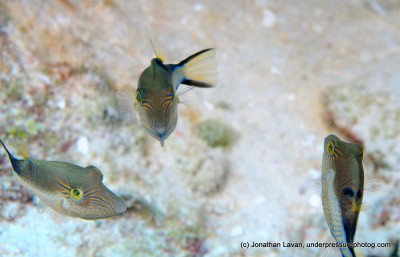Caribbean Creature Feature: Sharpnose Pufferfish
Feb 27
The Bumble Bees of the Reef –
This month we look at the Sharpnose Pufferfish (Canthigaster rostrata) [gaster meaning belly and rostratus meaning long-snouted]. The Sharpnose is one of the most frequently seen pufferfish on the reef and a favorite of many divers for their hovering and curious, although slightly timid, behavior. With its well-rounded body and the fluttering action of its rear placed dorsal, anal and particularly its pectoral fins, the Sharpnose truly looks like a bumble bee visiting the garden. All Puffer/Porcupinefish have the unique and marvelous defense of being able to inflate themselves with water, ballooning to many times their original size. Growing to a maximum length of 4.5 inches, the larger inflated size can make the difference between becoming lunch and not becoming lunch for the diminutive Sharpnose.
Usually solitary but inquisitive, they will be seen buzzing around the reef on virtually all Caribbean dives. In the above photograph, taken at the Blue Heron Bridge, we see the typical solitary Sharpnose, perhaps checking out its reflection in the camera’s flat port. Note how variable the color and pattern can be among this species. Sharpnoses are virtually unique among puffers for their pointed snouts, and the only other Caribbean pufferfish they might be confused with is the Goldfaced Toby (Canthigaster jamestyleri), which is a close cousin.
Misidentification, however, is unlikely for two reasons: first, Sharpnose Puffers rarely range below fifty feet, while the Goldface Toby ranges to three hundred feet and is generally found well below recreational dive limits, and as a result is seldom seen. The second reason is simply a question of body markings: Sharpnose will always have a dark border on the top and bottom of their caudal (tail) fin while the Goldface Toby will not.
I am often asked: “what is the difference between a ‘Puffer’ and a ‘Porcupine’ (also ‘Burr’) fish”. Porcupine (spines lay flat unless inflated) and Burrfish (spines always erect) have true spines while Pufferfish like our Sharpnose have much smaller spines called spinules that are generally found only on the abdomen and lower head rather than covering the entire body.

In our three group photos we see some unique Sharpnose behavior. There are three Sharpnose circling around each other and exhibiting bright, dynamic colors and markings. I took these shots in Cozumel, and it was the first and last time I was lucky enough to witness this behavior. This was undoubtedly some sort of precursor to mating, however other than zooming around each other in little circles for an extended period of time, no other specific behavior was witnessed – but boy was it fun to watch.

As mentioned earlier, these fish tend to be a bit shy but inquisitive, so they are usually easily approached, making them a perfect subject for the beginner to intermediate underwater photographer. Always remember to start shooting on the approach, within four feet of the subject, and just keep shuttering as you move in. It is always fun to personify fish with all their quirky behaviors and habits, and the Sharpnose Pufferfish is definitely up there as one of the cutest fish to watch and enjoy on the reefs of the greater Caribbean.

By: Jonathan Lavan
Jonathan Lavan: The owner/operator of Underpressure Diving & Nature Photography is a citizen scientist and wildlife expert and has been SCUBA Diving for thirty years and taking photographs both above and below the water for about 10. He was pleased to have been made Volunteer of the Year for 2012 by the Reef Environmental Education Foundation. As a SCUBA Diver he has been a photographer, teacher and research associate for many different organizations.He is a staunch environmentalist and educator of young people. Jonathan is committed to making a difference on this planet through his images and his message of good will to all creatures. www.underpressurephotog.com.





Related Articles
Popular Articles